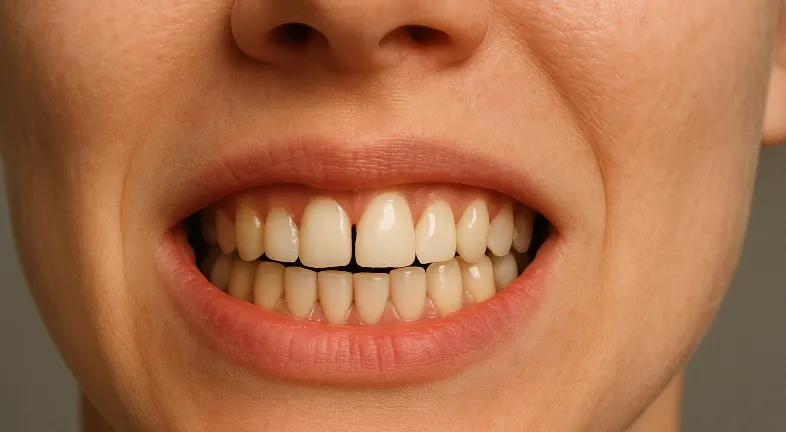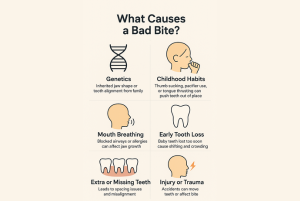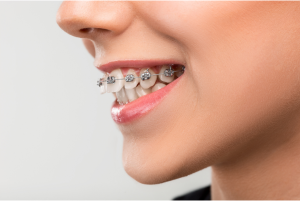
Have you ever looked in the mirror and wondered, “Do I need braces?” While many people think orthodontic treatment is only for teenagers with crooked teeth, the truth is that a bad bite can affect people of all ages. A misaligned bite doesn’t just impact the way your smile looks; it can also influence your speech, chewing, and even long-term oral health.
In this blog, we’ll break down the common signs you may need braces, the symptoms of a bad bite, and how to know if you need braces. It can help bring your teeth (and your confidence) back into alignment.
A “bad bite,” also known as a malocclusion, happens when your upper and lower teeth don’t fit together properly. Instead of meeting evenly, they may overlap, leave gaps, or shift out of place. Over time, this can lead to jaw discomfort, uneven tooth wear, or difficulty maintaining oral hygiene.
Orthodontists categorize bite problems into several types:
Each type of bite problem has its own challenges, and braces are often the most effective way to correct them.

One of the most obvious signs of misaligned teeth is when they overlap, twist, or crowd together. This is very visible when you smile or speak, as some teeth would be protruding or positioned behind other teeth. Teeth crowding may be due to genetics or uneven jaws. This not only affects your smile’s appearance but can also make brushing and flossing difficult, leading to a higher risk of cavities or gum disease.
If you often find yourself accidentally biting the inside of your cheeks or tongue, it may mean your teeth aren’t aligned properly. This is a common symptom of a bad bite and a sign your jaws aren’t meeting where they should.
You will most likely need braces if you feel pain in your jaws when you chew and speak. Severe bite problems can result in speech impediment and difficulty chewing, particularly if the jaw joints are already affected, and any movement causes pain. Some patients may also find it hard to pronounce certain words as the bite is off-kilter.
Alignment problems can put extra strain on your jaw joints (TMJ), leading to discomfort, clicking sounds, or even headaches. If left untreated, this strain can worsen over time.
Teeth spacing can be due to several factors, such as tooth loss and shifting of teeth, uneven jaw growth and development, genetics, and poor oral habits such as thumb-sucking or tongue-thrusting.
Spaces between the teeth are one of the most noticeable signs that indicate the need for dental braces. They look unsightly, so many patients want immediate treatment for them. While some people have small gaps, others have more significant gaps due to missing teeth. Braces are commonly recommended to correct teeth spacing issues.
When you close your mouth, your upper and lower teeth should meet in a way that distributes pressure evenly. If you notice that some teeth don’t touch while others overlap too much, that’s a strong sign of a bad bite.

For the teeth to be in proper alignment, enough force must be applied to encourage tooth movement. With traditional metal braces, the force comes from the metal brackets on the teeth held together by an archwire. With the constant application of force and pressure, braces can move the teeth to their correct positions and improve your bite, ultimately addressing many of the symptoms of a bad bite, such as jaw pain, difficulty chewing, or uneven tooth wear.
Your dentist can also adjust the amount of force applied to each tooth using rubber bands and fixed appliances that help guide the teeth into their ideal positions.
Knowing the right time for orthodontic treatment depends on your age and the severity of your bite issues. Children often get braces between the ages of 10 and 14, when most permanent teeth have come in. However, more adults than ever are choosing braces or clear aligners to fix long-standing bite problems.
If you notice any of the above crooked teeth signs or symptoms of bite issues, don’t wait. Orthodontic treatment works at almost any age and can prevent bigger dental problems down the line.
Braces and clear aligners are designed to gradually move teeth into their ideal positions. Here’s how they can help with bite problems:
Modern orthodontics also gives you options, from traditional metal braces to nearly invisible clear aligners, so you can choose the treatment that fits your lifestyle.
Some people may find that living with braces can be inconvenient because of the changes they have to incorporate into their lives. To solve that dilemma and fix the alignment of your teeth, clear aligners are an excellent solution.
Clear aligners (such as Caspersmile ) are discreet and removable teeth straightening treatments for mild to moderate misalignments. Instead of metal brackets, a series of plastic aligners moves the teeth through a snug fit. They are supplied in batches, with each aligner replaced once it has completed its job of shifting specific teeth, usually every 14 days.
The aligners are removable, so there is no need for diet restrictions. Simply pop them off before eating, brush your teeth, and rinse your aligner before placing it back in your mouth. Aligners must be worn for at least 22 hours a day, and with excellent compliance, you can see results in just a few months.
If you’ve been noticing crooked teeth, jaw discomfort, or other symptoms of a bad bite, it might be time to think about orthodontic treatment. Braces and clear aligners don’t just improve the way your smile looks; they also protect your long-term oral health by making it easier to chew, clean your teeth, and avoid unnecessary strain on your jaw.
Every smile is unique, so the right solution depends on your specific needs. Whether it’s traditional braces for complex bite issues or clear aligners for a more convenient, discreet option, treatment can transform both your appearance and confidence.
If you relate to any of the signs discussed in this blog, don’t ignore them; it may be the right time to explore braces or aligners and take the first step toward a healthier, more balanced smile.




Curated the best for your knowledge
.png) Metallic Taste in Mouth: Causes and How to Get Rid of It
Metallic Taste in Mouth: Causes and How to Get Rid of ItHaving metal taste in the mouth first thing in the morning can be an unexpected experience. You wake up, take a swallow, and suddenly have a metallic taste in your mouth, as if you'd been chewing on a handful of change. It's annoying, a little scary, and sometimes for no apparent reason. For some people, it will be nothing but a minor nuisance; others may fall into the late-night goose chaser. Sometimes it's a sign that there is something wrong with your braces; other times, it could mean that there is something wrong with one of your teeth. But here's the good news: Most metallic tastes are temporary, harmless, and can be treated or resolved. So let's take a closer look at the possibilities.
Read More How Molar Bands Work in Braces and Retainers to Keep Your Teeth in Line
How Molar Bands Work in Braces and Retainers to Keep Your Teeth in LineIf you’ve ever started orthodontic treatment, you already know there are a lot of tiny pieces involved. Wires, brackets, elastics, retainers, attachments… and then there are molar bands. They’re not as famous as braces themselves, but they play a surprisingly big role in keeping your smile moving in the right direction. Some people don’t really notice them. While others desperately want to know why that metal ring is even there. So let’s break it all down: what molar bands are, why orthodontists use them, and how they work in both braces and retainers. Plus, what you should expect throughout the process.
Read More.webp) Dental Bonding Cost: Prices, Process & What to Know
Dental Bonding Cost: Prices, Process & What to KnowIf you’re thinking about fixing a chipped tooth, closing a gap, or smoothing out uneven edges, dental bonding is often the easiest (and quickest) way to do it. And honestly? It’s one of the most budget-friendly cosmetic treatments out there, if you know what to expect. But here’s the part everyone worries about first: “How much does tooth bonding cost?” The short answer: it depends. The long answer: let’s break it all down so you actually understand where the price comes from, what you’re paying for, and whether bonding is the right fix for your smile.
Read MoreQuick Links

Heading